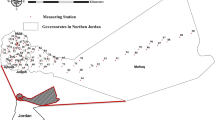Abstract
Using a large database of residential short-term radon measurements in New Hampshire, this study evaluated the ability of expert-assigned bedrock radon potential for predicting residential radon concentration. First, each bedrock type was assigned a radon potential level by a geologist familiar with the local geology. Then, using residential radon measurements, a continuous surface of radon concentration was generated through a kriging process. The mean residential radon concentration within the spatial extent of each bedrock type was then calculated based on that surface. The Spearman Rank Correlation Coefficient was calculated between the two ranks of the bedrock types, one based on the expert-assigned potential level and the other based on the mean residential concentration. A strong correlation between the rank correlation and the area of the bedrock type was found. When only the 15 largest bedrock types were used, the Spearman Correlation Coefficient reached 0.6. Geological knowledge is concluded to be useful in predicting and mapping residential radon concentration, but the prediction should be interpreted with caution, especially for areas in which the underlying bedrocks are highly localized.




Similar content being viewed by others
References
Apte MG, Price PN, Nero AV, Revzan KL (1999) Predicting New Hampshire indoor radon concentrations from geologic information and other covariates. Environ Geol 37:181–194
Chen J (2003) Estimate of annual average radon concentration in the normal living area from short-term tests. Health Phys 85:740–744
Cui L-P (1990) Radiometric methods in regional radon hazard mapping. Nucl Geophys 4:353–364
Geiger C, Barnes KB (1994) Indoor radon hazard: a geographical assessment and case study. Appl Geogr 14:350–371
Gundersen LCS, Schumann RR (1993) Preliminary geologic radon potential assessment of New Hampshire. In: Schumann RR (ed) Geologic radon potential of EPA region 1, US Geological Survey Open-file report 93-292-A, pp 157–190
Gundersen LCS, Schumann RR (1996) Mapping the radon potential of the United States: examples from the Appalachians. Environ Int 22:829–837
Hudak PF (1996) Distribution of indoor radon concentrations and uranium-bearing rocks in Texas. Environ Geol 28:29–33
Kemski J, Klingel R, Siehl A (1996) Classification and mapping of radon affected areas in Germany. Environ Int 1(22 Suppl.):789–798
Kemski J, Siehl A, Stegemannb R, Valdivia-Manchegob M (2001) Mapping the geogenic radon potential in Germany. Sci Total Environ 272:217–230
Kemski J, Klingel R, Siehl A, Stegemannb R (2005) Radon transfer from ground to houses and prediction of indoor radon in Germany based on geological information. Radioact Environ 7:820–832
Lyons JB, Bothner WA, Moench RH, Thompson JB Jr (1997) Bedrock geologic map of New Hampshire: U.S. Geological Survey Special Map, 2 map sheets, 1:250,000
Miles JCH (1998) Development of maps of radon-prone areas using radon measurements in houses. J Hazard Mater 61:53–58
Miles JCH, Appleton JD (2005) Mapping variation in radon potential both between and within geological units. J Radiol Prot 25:257–276
Miles JCH, Ball K (1996) Mapping radon-prone areas using house radon data and geological boundaries. Environ Int 1(22 Suppl.):779–782
Morland G, Strand T, Furuhaug L, Skarphagen H, Banks D (1998) Radon in quaternary aquifers related to underlying bedrock geology. Ground Water 36:143–146
Pearce J, Boyle P (2005) Examining the relationship between lung cancer and radon in small areas across Scotland. Health Place 11:275–282
Quindós Poncela LS, Fernández PL, Gómez Arozamena J, Sainz C, Fernández JA, Suarez Mahou E, Martin Matarranz JL, Cascón MC (2004) Natural gamma radiation map (MARNA) and indoor radon levels in Spain. Environ Int 29:1091–1096
Sundal AV, Henriksen H, Lauritzen SE, Soldal O, Strand T, Valen V (2004a) Geological and geochemical factors affecting radon concentrations in dwellings located on permeable glacial sediments—a case study from Kinsarvik, Norway. Environ Geol 45:843–858
Sundal AV, Henriksen H, Soldal O, Strand T (2004b) The influence of geological factors on indoor radon concentrations in Norway. Sci Total Environ 328:41–53
Acknowledgments
This work was supported by the National Institutes of Health (Grant # P20 RO18787). The authors are grateful to David Chase at NH Department of Environmental Services, who made substantial contribution to this paper but kindly refused the authorship. He provided the data of both the geologist’s classification and the indoor measurements, and also helped to formalize the idea of comparing the two. Geostatistical Analyst, ArcGIS and Spatial Analyst are registered trademarks of ESRI, Redlands, CA, USA.
Author information
Authors and Affiliations
Corresponding author
Rights and permissions
About this article
Cite this article
Shi, X., Hoftiezer, D.J., Duell, E.J. et al. Spatial association between residential radon concentration and bedrock types in New Hampshire. Environ Geol 51, 65–71 (2006). https://doi.org/10.1007/s00254-006-0304-3
Received:
Accepted:
Published:
Issue Date:
DOI: https://doi.org/10.1007/s00254-006-0304-3




